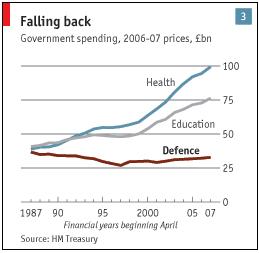
From The Economist, a very honest and direct view of where it (the British Army) stands - and where almost a decade of war has brought her.
British forces are organised to conduct, at the high end of operations, either one relatively brief “large-scale” war (requiring an army division, or about 30,000 men) or two simultaneous “medium-scale” campaigns (brigade-sized, involving around 4,500 men apiece). In the latter case, one operation could be a long-term peacekeeping mission and the other a short war; they would not both last longer than six months or involve prolonged combat.It isn't just the impact of war - it is years of neglect, and as a guy with a chart fetish - I think the graphs tell a lot of the story; and explain the major problem we have with our allies.
But since 2006 Britain has run two protracted and often intensely violent operations. Units routinely breach guidelines designed to give them time to minimise battle stress. The strain on soldiers, says General Sir Richard Dannatt, the army chief, is “unacceptable”. Britain has struggled to maintain two long supply routes, dividing scarce helicopters, engineers and medics. Aircraft are wearing out faster than planned. “The British army is like an engine running without oil. It is still going, but it could seize up at any moment,” argues Michael Clarke, director of the Royal United Services Institute, a think-tank.
These troubles are made worse by a chronic shortage of manpower. On October 1st the trained strength of the British armed forces was 173,270. This is 3.2% below the official requirement, but it understates large gaps in some areas—especially infantry units. Most battalions are 10-20% short of their required numbers; if those deemed unfit to deploy (due to, say, battle injuries) are factored out, they are as much as 42% under strength. So when battalions are preparing for war, they often regroup soldiers from their four scrawny companies into three, and then bolt on a fourth from another unit. To support current operations, the army has cut back training and lowered readiness; instead of having roughly a brigade at high readiness to deal with a crisis, sources say, there is “less than a battle-group” (a 1,500-strong formation).
On December 11th the government announced a delay of one or two years in building big new aircraft carriers, and the deferral of a new family of armoured vehicles. Even so, insiders say there is still a £3.7 billion ($5.2 billion) hole in the budget for military equipment over the next four years and procurement costs are still rising. The bill for the 20 biggest weapons projects is now £28 billion, or 12%, over budget.
Heavy spending on kit for the navy and air force leaves little for the army; one source says it will receive less than 10% of all spending on defence equipment between 2003 and 2018. The government notes, however, that better-protected transport vehicles and other things are being rushed in separately using the Treasury’s reserve funds; the force in Afghanistan is now the best-equipped that Britain has fielded (though it still trains with old kit).
How much should Britain spend on defence? At around 2.6% of GDP, its defence budget is high by European standards but below America’s 4% (see chart 2). Defence spending has lagged behind other government expenditure (see chart 3). One general says: “You cannot have a first-division army, navy and air force—and a nuclear deterrent—for £34 billion a year.”
 As we move towards a more Euro-socialist model, keep in mind the last graph. Politicians have their priorities, and until the wolf is at their neck - the Left will let its guard dogs starve.
As we move towards a more Euro-socialist model, keep in mind the last graph. Politicians have their priorities, and until the wolf is at their neck - the Left will let its guard dogs starve.
No comments:
Post a Comment